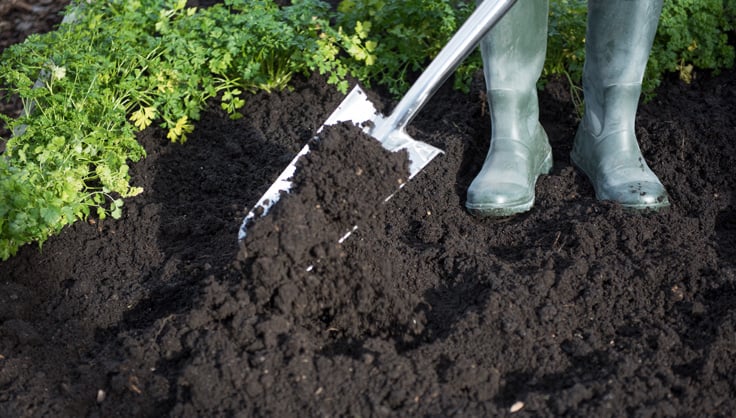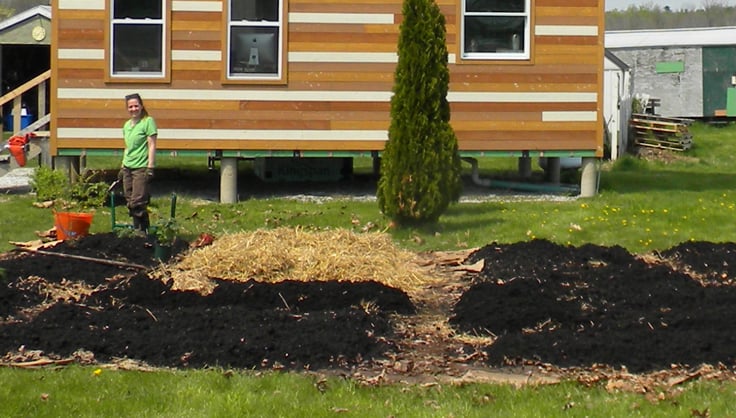Regenerate Your Soil
Quick tips for building healthy soil

Healthy soils are the foundation for healthy gardens, healthy people, and a healthy planet. The practice of tending to soil health isn't new. Generations ago, farmers and gardeners took care of their soil because they had to — soil health meant food could be put on the table. However, the surge in synthetic fertilizers, coupled with deforestation, overgrazing, intense cultivation, and major development pressure has led to global degradation of our planet's soils. Fortunately, there are ways to bring soil back to life, and to continually nurture the underground ecosystem — plants, animals, fungi, bacteria, etc. — that keep the above-ground ecosystem, including your garden, thriving.
What is Healthy Soil?
It is a common misnomer that soil is an inert substance (that's "dirt"!). However healthy soil is dynamic ecosystem chock full of carbon, nitrogen, and other elements. It is also teeming with insects, nematodes, fungi, and bacteria.
Healthy soil has a huge impact on the function and resilience of the rest of our planet. When healthy, soil:
- Sustains plant and animal life
- Filters potential pollutants
- Regulates the flow of rain, snow, and irrigation
- Cycles carbon, nitrogen, phosphorous, and many other nutrients
- Provides physical structure
How to Regenerate Your Soil
The term "soil regeneration" simply refers to the practice of building (or rebuilding) healthy soil. Here are 3 easy things you can do to regenerate your garden soil:
Compost
Compost has two huge benefits: 1) Composting at home prevents your kitchen and garden waste from being trucked off to a landfill, where it will produce methane — a greenhouse gas with a global warming potential 25 times that of carbon dioxide; and 2) When added to the garden, finished compost will increase the biological activity, fertility, and water-holding capacity of your soil, resulting in gorgeous, resilient flowers, herbs, and veggies.
Mulch
Natural mulch (not black the synthetic black plastic kind used to prevent weeds) includes:
- shredded bark
- leaves (either shredded or made into leaf mold)
- straw
- wood chips
Mulching with these substances can do A LOT for regenerating depleted soil. When layered on top of a bed, mulch adds carbon back into the soil, prevents topsoil loss from erosion, and helps soil conserve moisture.
Planting cover crops as a "living mulch" can help regerenate depleted soil, as well. When grown in poor, clay soils, cover crops utilize space that would not otherwise be productive. Over time, these otherwise not productive spaces can become incredibly productive as the soil biome matures. Some of our favorite cover crops are: winter rye, buckwheat, peas, clover, and borage.
Use organic fertilizers
Organic fertilizers are made from naturally occurring mineral deposits and organic material, such as bone or plant meal or composted manure. Synthetic fertilizers (imagine that blue powdery stuff) are manufactured from mineral or gas elements. In general, synthetic fertilizers release nutrients quickly and only feed the plant — organic fertilizers are released to the plants slowly over a longer period of months or even years, as they aren't water-soluble. Organic fertilizers also help feed the entire soil complex by stimulating beneficial soil microorganisms and improve the structure of the soil. Soil microbes play an important role in converting organic fertilizers into soluble nutrients that can be absorbed by your plants. In most cases, organic fertilizers and compost will provide all the secondary and micronutrients your plants need.
 The start of healthy garden soil: chock full of compost and mulch!
The start of healthy garden soil: chock full of compost and mulch!
Print this Article:
Get the Dirt
Stay up to date on new articles and advice. Please fill out the information below.

